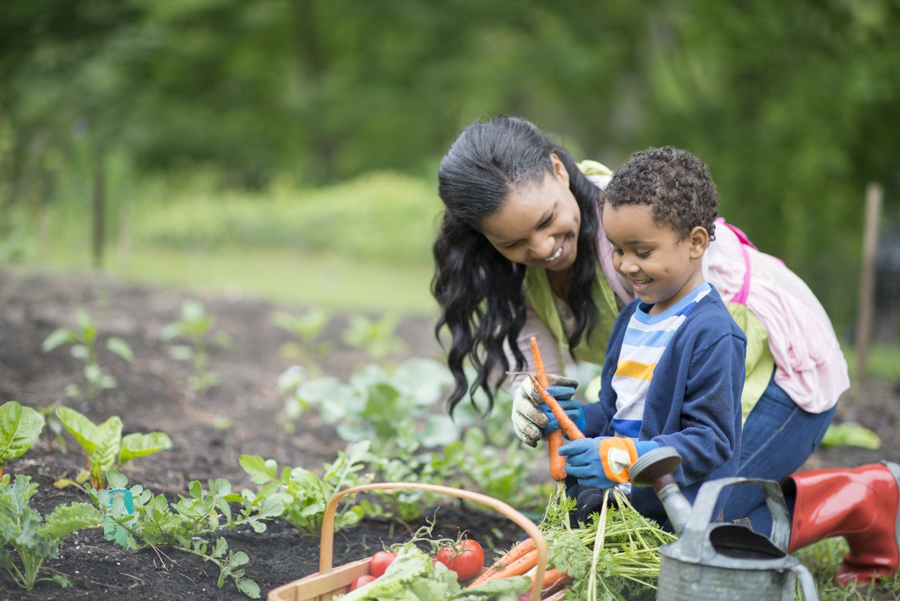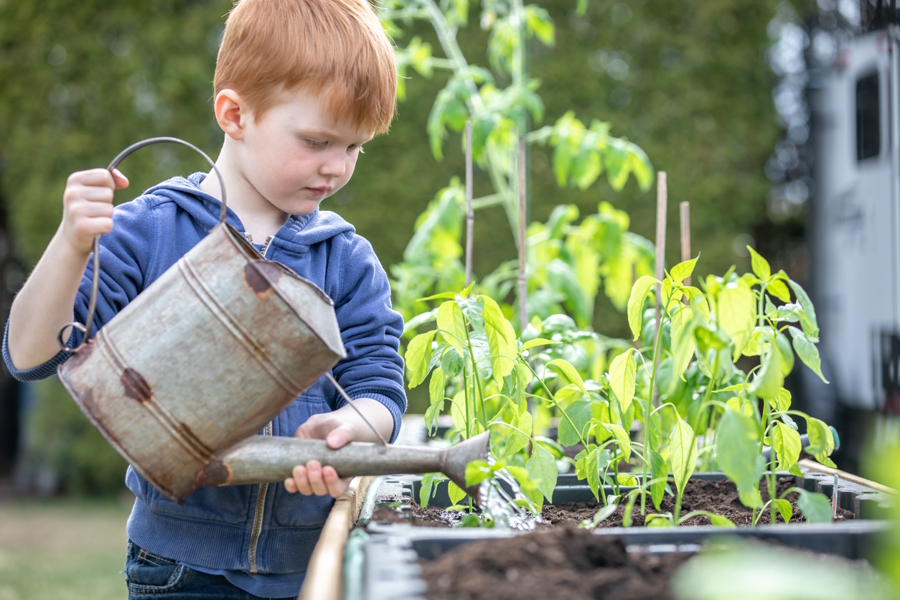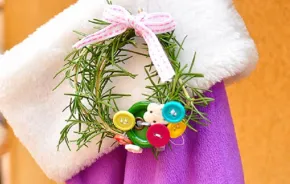
Photo:
iStock
After nearly 30 years of digging in the dirt, I’ve learned a thing or two about growing vegetables — and there’s nothing more satisfying than putting homegrown, nutritious food on the table for my family. But let’s be real: Getting those picture-perfect veggies, like the ones at your local market, isn’t always easy — especially with the unpredictable Pacific Northwest weather. Over the years, I’ve turned to expert gardeners, poured over “Growing Vegetables West of the Cascades” (the ultimate Northwest gardening guide), and leaned on the wisdom of Tilth Alliance and fellow urban farmers. Through plenty of trial and error, I’ve transformed my garden into something I’m proud of. And guess what? With a little patience and know-how, you can too!
1. It’s the soil — and how you prepare it.
To grow great vegetables, you’ll need to start with the right soil. Most soils are a combination of sand, silt, clay and organic matter, with the percentage of each component determining what type of soil you have. Given Seattle’s past glacial cover, you are likely to find both sand and clay soil types in your yard.
Sandy soil is easy to till and it drains well, but that is also the problem — it doesn’t retain water or nutrients very well. Loamy soil is what you are hoping for! This soil is easy to work, drains well, and retains moisture and nutrients for overall good soil composition. Clay soil drains poorly and be can be hard to work with — it clods when wet and is dusty when dry. Seeds struggle to emerge from clay soil, and plants have a hard time growing successfully.
A simple test for assessing your soil type is the “squeeze test.” Wait until March or April when the soil has started to dry out from the wet winter. Take a handful of moist (but not overly wet) soil from your garden-bed-to-be and give it a firm squeeze.
- If the soil falls apart, you have sandy soil.
- If the soil holds its shape but falls apart when you poke it, you have loamy soil.
- If the soil holds its shape even when poked, you have clay soil.
So now you know what soil type you have. What, if anything, should you do about it? For sandy soil, till 2 inches of organic compost into the top few inches of your garden. It is especially important that the top inch or two have adequate compost to help support seed germination.
If you have loamy soil (lucky you!), you’ll only need to worry about tilling it while wet, and possibly mixing one-quarter of an inch of organic compost into the top 6 inches of soil.
Despite the love and good intentions of even the best gardener, clay soil will not be transformed into good gardening soil — I learned this the hard way. It will not mix properly or embrace added compost. Instead, plan on buying some good-quality vegetable garden soil and place about 6 to 8 inches on top of the existing soil. Dig down through the new soil and into your existing soil about 3 inches. Till well together, and you’ll be on your way to having great soil! This process helps to create mounds, and is often why urban gardeners opt for raised planter beds to hold their new soil in place.
No matter what type of soil you have, you will need to prepare it for planting, so get ready to do some work. If it is a new planting area, dig up the grass or other plants and make sure all of the roots are removed. Take a shovel and turn over the soil (dig it up a couple of times), going at least a foot deep. Your soil should be turned every spring, even in existing garden beds. You may also need to break up clumpy dirt and pull out leftover roots from last season.
Depending on what type of soil you have, augment with organic compost as needed. On my existing beds, I mix in about half an inch or so of organic vegetable bed compost. I turn the top 6 to 8 inches of soil over again and level with a rake or hoe. Now the beds are almost ready for planting!

2. It’s the fertilizer — and you can make it!
Besides great soil, plants require fertilizer to flourish and produce. When possible, consider making your own organic fertilizer as it can be hard to find a prepared mix that is suitable for the unique mineral composition of Pacific Northwest soil. Here is a helpful recipe from Steve Solomon that is perfect for our environment. All of the organic components can be found at local nurseries or garden stores:
- 8 dry cups cottonseed meal
- 1 dry cup lime — use dolomite
- 1 dry cup phosphate rock
- 1 dry cup kelp meal
This 11-cup mix will make enough to broadcast over approximately 50 square feet of garden space. Dig or hoe this into the first 4 inches of tilled soil before you plant your seeds. Garden experts recommend side dressing every four to six weeks, but I have never done this (shame on me — I pledge every year to be better!). I do re-fertilize the soil if I am planting new seeds or a second crop after the first has been harvested.
If you don’t want to make your own fertilizer, you can buy a great blend from Walt’s Organic Fertilizer in Seattle’s Ballard neighborhood.

3. It’s the timing — and the weather.
Here’s where things get a little tricky. Different vegetables need to be planted at different times. Follow guidelines flexibly, and pay attention to the weather. Here in Seattle, we can have spring weather where the average temperatures run 5 or 6 degrees above or below normal. This differential will definitely affect the chances of your seeds germinating. There have been years when I have had to replant my seeds because it was too cold for them to germinate and they rotted in the soil.
Reference the required soil temperature listed on each seed package and then take the soil temperature. I use an instant thermometer to do this, but soil thermometers are also available at garden supply stores. Between noon and 2 p.m., insert the thermometer 2 inches into the soil where you plan to plant and record the temperature. Repeat this step for three to four days in a row and average the resulting temperatures. When the soil registers as warm enough, begin planting!
For heat-loving vegetables such as beans, cucumbers, squash and corn, the soil needs to be above 60 degrees and night temps need to remain above 50 degrees. Plant these veggies when it looks like we will be having a stretch of warm, sunny days.
Though planting is ultimately determined by the soil and air temperature, I make a planting schedule after deciding on what will be grown. The following advice is sound for growing vegetables from seeds sowed directly in the garden:
- First planting in mid-March — peas
- Second planting in late March/early April — beets, scallions, cilantro, carrots
- Third planting in mid-April — lettuce, broccoli, spinach, chives, fennel bulbs
- Fourth planting in late April/early May — carrots, cilantro, dill, cauliflower
- Fifth planting in May — pole beans, summer squash, lettuce
- Sixth planting in early June — cucumbers, corn
Given that we can have cold springs, many of these dates can get pushed back. The watchwords for gardening in the Northwest: flexibility and patience!

4. It’s the spacing — it really does matter.
Try to buy your seeds from a Northwest seed company, as they will have varieties that can grow in our shorter growing season. Follow the seed package spacing and thinning instructions when you plant. This can be frustrating for urban gardeners who want to get as much as they can out of a small planting area. I only started getting vegetables that looked like those you see at the market when I stopped crowding my plants. Yes, lettuce really does need to be spaced 12 inches apart to get a real head — don’t fight it! Here are spacing recommendations that I use in my garden:
- Beans — Many varieties need a pole to grow on; thin established plants 8–10 inches apart.
- Beets — Plant rows 18 inches apart; when seedlings are 3 inches high, thin to 1 inch apart for baby beets, 3–4 inches for mature beets, 6 inches for winter storage beets.
- Broccoli — Center plants 24 inches apart in rows 4 inches apart. Complete thinning when the plants have three true leaves.
- Carrots — Plant rows 18 inches apart; when seedlings are 2–3 inches tall, thin to 1.5 inches apart.
- Cauliflower — Center plants 24 inches apart.
- Corn — Needs to be grown with at least four rows 30 inches apart. Thin plants to 8 inches apart in the rows. Corn needs to be grown in a block so it can pollinate itself. If you don’t have an area at least 8 by 4 feet receiving eight hours of sun, consider other vegetable options for your space.
- Cucumbers — Space 18-inch mounds about 2–3 feet apart. Plant four to five seeds; when seedlings have their first true leaf, thin to one plant per mound.
- Lettuce — Plant rows 24 inches apart, thin seedlings for loose-leaf 10–12 inches apart; for iceberg, bibb and romaine, thin to 12–14 inches apart. When plants are 2–3 inches in diameter, sow new rows in between the started ones. This will keep you in lettuce all summer!
- Parsley — Plant rows 18 inches apart, thin plants to 3 inches apart.
- Peas — Plant rows 18 inches apart — do not thin.
- Radishes — Plant rows 12 inches apart; thin plants to 2 inches apart.
- Spinach — Plant rows 14–18 inches apart, thin seedlings to 3 inches apart when plants are 3 inches in diameter, then thin to 6–8 inches apart if you want large plants to pick leaves from.
- Swiss chard — Plant rows 18 inches apart; thin seedlings to 10–12 inches in the rows.
- Squashes — Space mounds 2–3 inches apart, in rows 4 inches apart. Sow three to four seeds; thin to one per mound.
- Tomatoes — Center plants 2–3 feet apart.
- Zucchini — Space mounds 2–3 inches apart, in rows 4 inches apart. Sow three to four seeds; thin to one per mound.

5. It’s what you grow — pick veggies that thrive in the Pacific Northwest.
Here’s the fun part — deciding what you’d like to grow! Plant what you like to eat and what will work in your yard, soil- and space-wise. Not all vegetables do well in Seattle, given our short, cool summers. Forget warm-weather crops like eggplant and peppers! Here are 16 veggies that do well in the Pacific Northwest:
- Beans — These are fun to watch and they keep on delivering! Not too fussy about soil type, but pole beans need something to climb on, up to 7 feet high.
- Beets — Any soil type works.
- Broccoli — Best grown in loamy soil, but will tolerate other soil types. Broccoli can also be planted in the fall for an early spring crop.
- Carrots — Germination time is long, so be patient! Carrots do need well-tilled loamy soil to mature beyond the pudgy stub state.
- Cauliflower — Said to be a difficult vegetable to grow, but I’ve had great luck!
- Corn — Fresh corn is the best. Almost any soil will do, just make sure it is well fertilized. As I mentioned earlier, plant only if you have the space and hope for a warm summer!
- Cucumbers — Loamy soil and warm weather are needed, but it’s fun to find the cucumbers growing amongst the vines.
- Lettuces — These thrive in well-fertilized loamy soil, but thinning is needed to produce big heads. Replant every few weeks to enjoy fresh lettuce all summer long.
- Parsley — Loamy soil is a must. Plants will last through the winter.
- Peas — An early planting and producing crop, peas need loamy soil. Some peas don’t need a trellis, but snow and snap peas may; read the seed package carefully.
- Pumpkins — Vines need a lot of space and heat; start indoors and transplant when it is warm.
- Radishes — An early crop that requires loamy soil; fast-growing, so a late-planting vegetable can take its place when harvested.
- Spinach — Needs loamy, well-fertilized soil; underground pests and bad weather can deter you, but keep trying.
- Swiss chard — A poor-soil-forgiving plant that is beautiful and will grow through the winter.
- Summer squashes — Need loamy warm soil and room; will produce for a couple of months; be sure to plant colorful cosmos nearby to attract bees!
- Tomatoes — A ripe tomato off the vine is like eating sun candy! Buy mature plants from a nursery that will grow in our cooler summers. I always plant a couple of Early Girls and at least one Roma or plum-type tomato plant. Most plants will need to be staked as they grow, with the new growth tied up every couple of weeks. Toward the end of the summer, nip new flower growth and don’t overwater when the fruit is ripening.
More spring family fun: |
Editor’s note: This article was originally published a few years ago, and updated most recently on April 3, 2025, by ParentMap’s associate editor, Kari Hanson. All information was fact-checked.











